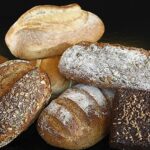
Brötchen are the heart and soul of the German breakfast table. These small, crusty rolls are as essential to German life as coffee or butter. Whether picked up fresh from the local bakery at dawn or baked at home on a lazy Sunday morning, Brötchen (literally “little breads”) are a tradition that never goes out of style. In this recipe, you’ll learn how to make them from scratch – crusty on the outside, fluffy on the inside, and full of authentic flavor.
The Origins of Brötchen
Brötchen are found in every corner of Germany, from the bustling bakeries of Berlin to quiet village shops in Bavaria. Though simple, these rolls are steeped in regional pride. In the north, you might hear them called Schrippen; in Swabia, Weckle; in Franconia, Kipf; and in Austria, Semmeln. Whatever the name, the concept is the same: a roll that’s light yet satisfying, with a golden crust and soft center.
They’re most commonly eaten for breakfast (Frühstück) or as part of Abendbrot (a light evening meal), typically served with butter, jam, cold cuts, cheese, and soft-boiled eggs. Brötchen are also the go-to bread for lunchbox sandwiches across the country.
Ingredients & Preparation
Ingredients for Authentic Brötchen Recipe
- 4 cups (500g) bread flour
- 1½ teaspoons salt
- 1 teaspoon sugar
- 2¼ teaspoons (1 packet) active dry yeast
- 1½ cups (360ml) warm water
- 2 tablespoons vegetable oil
- Optional: semolina or cornmeal for dusting the tray
Recommended tools:
- Mixing bowl
- Dough scraper
- Kitchen scale
- Baking sheet
- Spray bottle with water (for steam)
Step-by-Step Instructions
1. Make the dough
In a mixing bowl, dissolve the yeast and sugar in the warm water. Let it sit for 5–10 minutes until foamy. Add the flour, salt, and oil. Mix until a rough dough forms.
2. Knead the dough
Turn the dough onto a floured surface and knead for about 10 minutes, or use a stand mixer with a dough hook for 6–7 minutes. The dough should be smooth and elastic.
3. First rise
Place the dough in a lightly oiled bowl, cover it, and let it rise for 1 hour in a warm spot until doubled in size.
4. Shape the rolls
Punch down the dough and divide it into 10–12 equal pieces. Shape each piece into a tight ball or small oval. Place them on a parchment-lined or lightly floured baking sheet.
5. Second rise
Cover loosely with a towel and let rise for another 30–40 minutes.
6. Preheat and score
While the dough rises, preheat the oven to 450°F (230°C). Right before baking, score the tops of the rolls with a sharp blade and spray with water.
7. Bake until golden
Bake for 18–20 minutes, spraying water into the oven after 5 minutes to create steam. The rolls are done when golden brown and hollow-sounding when tapped.
8. Cool and enjoy
Cool on a wire rack for at least 15 minutes before serving.
How to Serve Brötchen
Brötchen shine in their simplicity. Germans often enjoy them split open and topped with:
- Butter and fruit preserves
- Slices of ham, cheese, or salami
- Nutella or honey
- Soft-boiled eggs and fresh herbs
- Smoked salmon and cream cheese
They’re also the perfect bread for sandwiches, especially when paired with crisp lettuce, sliced tomatoes, and spicy mustard.
Variations & Regional Styles
There are countless regional styles of Brötchen. Some use whole wheat or spelt flour, while others include seeds like poppy, sesame, or sunflower on top. In Bavaria, you’ll find Laugenbrötchen (pretzel rolls), dipped in a lye solution before baking. In northern Germany, crustier versions with a chewy texture are the norm.
You can also shape them in fun ways – round, oval, twisted, or scored with decorative cuts to mimic bakery styles.
Making Brötchen at home is a rewarding and delicious way to bring a bit of Germany to your kitchen. Light, crusty, and endlessly customizable, these little rolls are the backbone of countless meals and memories across the country.
Ready to try more? Explore recipes for Pumpernickel, Pretzels, and German Rye Bread to continue your journey through our German Bread Recipes collection.







